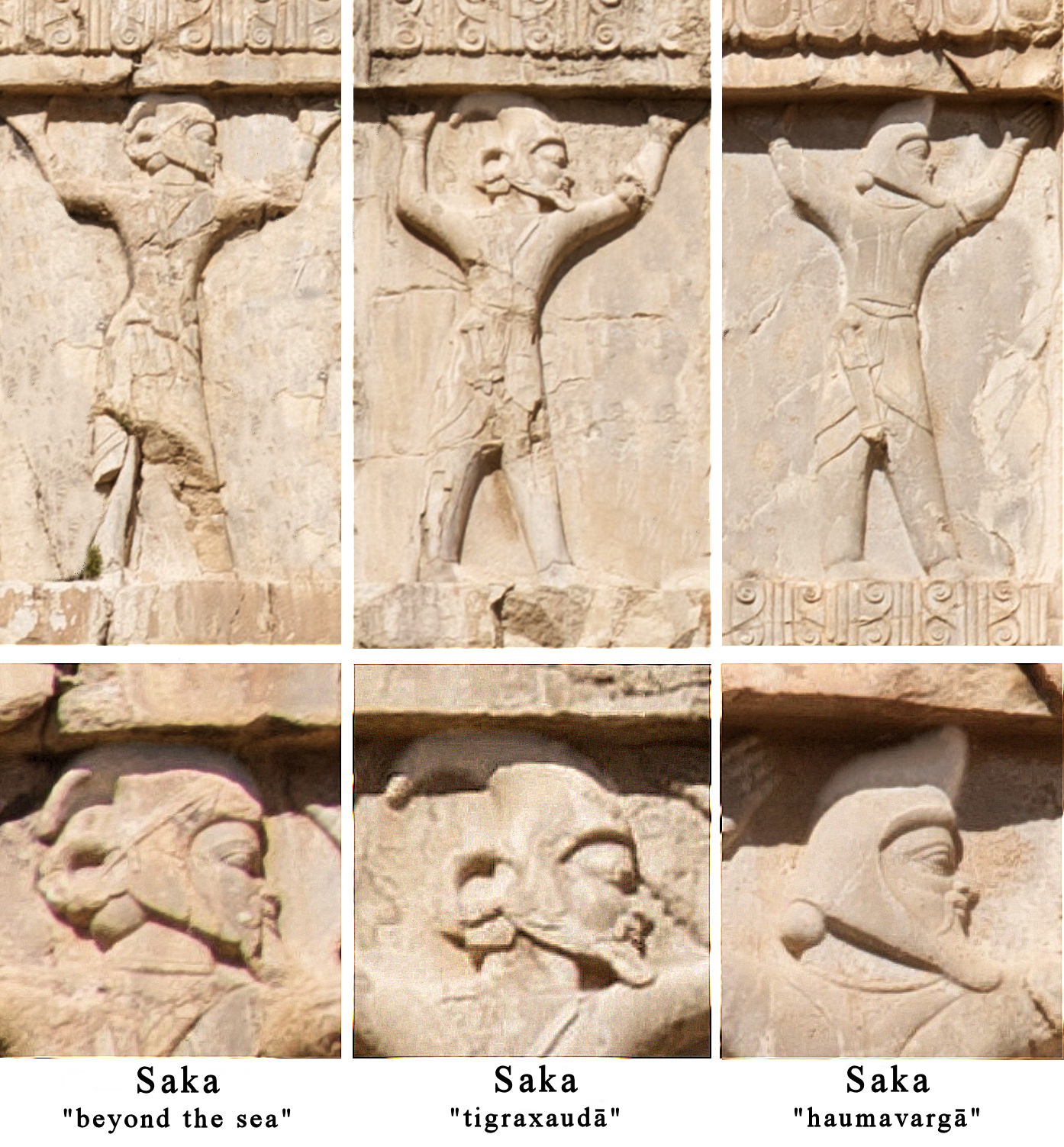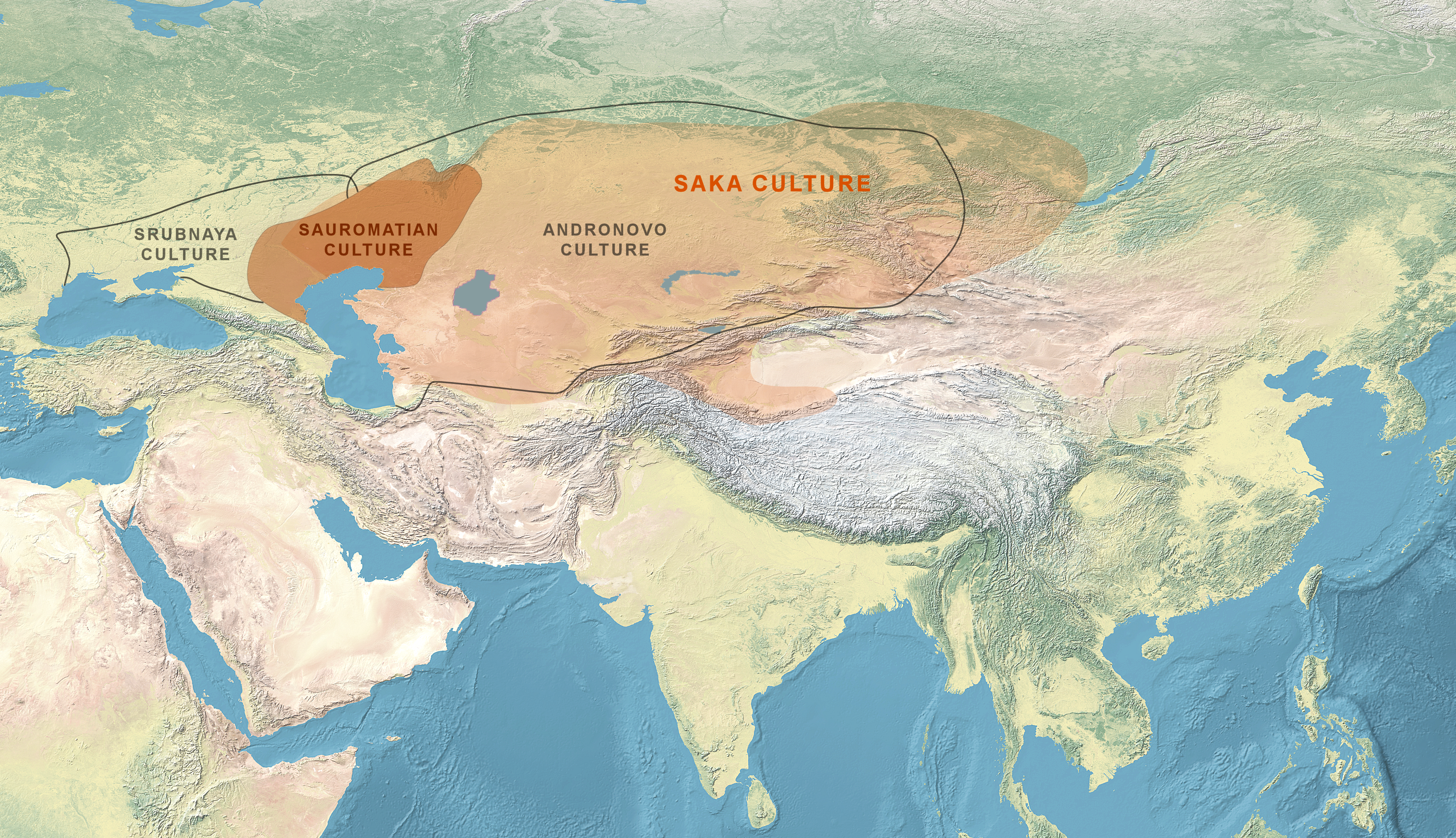|
Tasmola
The Tasmola culture was an early Iron Age culture during the Saka period (9th to 4th centuries BC) in central Kazakhstan. The Tasmola culture was replaced by the Korgantas culture. They may correspond to the Issedones of ancient Greek sources. Burials Everything known about the Tasmola culture originates from the barrows (or kurgans) they built to bury their deceased. The necropoles involve mainly a large barrow and an adjoining small one. Tasmola kurgans were rather large during the early period (30–50m diameter, 3–5m in height), but were smaller in the later period (15–25 m in diameter, 0.5–1.5m in height). They were grouped in cluster of 10 to 15 kurgans. They were often equipped with a central passageway, or ''dromos'', leading to the area of the burial. Kurgans of the Tasmola culture have been carbon-dated, and range from 894–790 cal BC (kurgan 8 of the Karashoky cemetery) for the earliest, to 509–377 cal BC (kurgan 3 of the Taisoigan cemetery) for the latest. L ... [...More Info...] [...Related Items...] OR: [Wikipedia] [Google] [Baidu] |
Barrows Of Tasmola
The Barrows (or Tumuli) of Tasmola are dispersed throughout central Kazakhstan in the Karaganda, Akmola, and Pavlodar regions. Site description Originating in the Saka period (7th to 3rd Centuries BC), the various barrows of the Tasmola culture can be found throughout the valleys of central Kazakhstan. The sites are characterized by stone complexes with up to four stone barrows, menhirs (single or in groups), and two curved ranges that can each stretch 50 to 200 m long (unique to Tasmola structures). The ranges appear to line up in accordance to equinoctial, solstitial or midsummer sunrise points. Archaeological finds in the barrows themselves can include pottery, horse skeletons, and fire pit remains. Over 300 of such barrows have been identified in Kazakhstan, of which only a small number have been archaeologically excavated. The last characteristic Tasmola kurgans seem to date to the 5th–4th century BCE. World Heritage Status This site was added to the UNESCO World Herit ... [...More Info...] [...Related Items...] OR: [Wikipedia] [Google] [Baidu] |
Saka
The Saka, Old Chinese, old , Pinyin, mod. , ), Shaka (Sanskrit (Brāhmī): , , ; Sanskrit (Devanāgarī): , ), or Sacae (Ancient Greek: ; Latin: were a group of nomadic Iranian peoples, Eastern Iranian peoples who lived in the Eurasian Steppe and the Tarim Basin from the 9th century BC to the 5th century AD. "Modern scholars have mostly used the name Saka to refer specifically to Iranians of the Eastern Steppe and Tarim Basin" "In modern scholarship the name 'Sakas' is reserved for the ancient tribes of northern and eastern Central Asia and Eastern Turkestan to distinguish them from the related Massagetae of the Aral region and the Scythians of the Pontic steppes. These tribes spoke Iranian languages, and their chief occupation was nomadic pastoralism." The Saka were closely related to the Scythians, and both groups formed part of the wider Scythian cultures. However, they are distinguished from the Scythians by their specific geographical and cultural traits. The Saka la ... [...More Info...] [...Related Items...] OR: [Wikipedia] [Google] [Baidu] |
Korgantas Culture
The Korgantas culture (c. 400-113 BCE) replaced the Tasmola culture in Central Kazakhstan. It is used sometimes termed as the "Korgantas period" of the Tasmola culture. The tombs of the Korgantas period differ significantly from those of the earlier Tasmola, lacking dromos passageways, and being smaller, with animal sacrifices arranged near the head. The burials are often covered with a chaotic assemblage of stones, and the dead were oriented to the East or the Northeast. Many characteristics of these burials, especially the heads of sacrificed animals, are similar to those of early Hunnic burials. In a recent study, various Korgantas period graves were carbon-dated to between 400 and circa 100 BCE cal. Genetically, the Korgantas period seems to mark an influx of Ancient Northeast Asians (Devils_Cave_N profile) in Central Asia. Of four Korgantas individuals analysed in a recent study, three had about 50% Ancient Northeast Asians (Devils_Cave_N) ancestry combined with about 50% ... [...More Info...] [...Related Items...] OR: [Wikipedia] [Google] [Baidu] |
Begazy–Dandybai Culture
Begazy-Dandybai culture (c. 1500-1100 BCE), is a late Bronze Age culture of mixed economy in the territory of ancient central Kazakhstan, Kyrgyzstan, and Uzbekistan, centered at Saryarka region. The Begazy Dandybai Mausolea dates from –1150 BCE, and was previously dated between the 12th and 8th centuries BCE, or from 13th to 10th centuries BCE. The culture was discovered, first excavated, and published in the 1930s–1940s by M.P. Gryaznov, who took it for a local version of the Karasuk culture. In 1979 the Begazy-Dandybai culture was described and analyzed in detail in a monograph by A.Kh. Margulan, who systematically reviewed accumulated material and produced description of the archeological culture. The most famous monuments of Begazy-Dandybai culture are Begazy, Dandybai, Aksu Ayuly 2, Akkoytas, and Sangria 1.3, it was named after the first two archeological sites. Begazy-Dandybai culture is known from the 2nd millennium BCE with mining copper, tin, and gold ore deposits. ... [...More Info...] [...Related Items...] OR: [Wikipedia] [Google] [Baidu] |
Ancient Northeast Asian
In archaeogenetics, the term Ancient Northeast Asian (ANA), also known as Amur ancestry, is the name given to an ancestral component that represents the lineage of the hunter-gatherer people of the 7th–4th millennia before present, in far eastern Siberia, Mongolia and the Baikal regions. They are inferred to have diverged from Ancient East Asians about 24kya ago, and are represented by several ancient human specimens found in archaeological excavations east of the Altai Mountains. They are a sub-group of the Ancient Northern East Asians (ANEA). ANA ancestry is represented by hunter-gatherer remains from the Amur region, as well as remains found in present-day Mongolia. Origins The Paleolithic origins of Ancient Northern East Asians (ANEA) are not well clarified, mainly due to the lack of archaeological specimens. So far, the oldest populations for which genomic data have been obtained are the "Basal East Asian" Tianyuan man ( BP), as well as the Amur33K (c. 33,000 BP) s ... [...More Info...] [...Related Items...] OR: [Wikipedia] [Google] [Baidu] |
Scythian Cultures
The Scythian cultures was an archaeological horizon that flourished across the Eurasian Steppe during the Iron Age, from approximately the 9th century BC to the 2nd century AD. It included the Scythian, Sauromatian and Sarmatian cultures of Eastern Europe, the Saka- Massagetae and Tasmola cultures of Central Asia, and the Aldy-Bel, Pazyryk and Tagar cultures of south Siberia. The Scythian-Siberian world was characterized by the Scythian triad, which are similar, yet not identical, styles of weapons, horses' bridles, and jewelry and decorative art. The question of how related these cultures were is disputed among scholars. Its peoples were of diverse origins, and included not just Scythians, from which the cultures are named, but other peoples as well, such as the Cimmerians, Massagetae, Saka, Sarmatians, and obscure forest-steppe populations. Mostly speakers of the Scythian branch of the Iranian languages, all of these peoples are sometimes collectivel ... [...More Info...] [...Related Items...] OR: [Wikipedia] [Google] [Baidu] |
Issedones
The Issedones () were an ancient people of Central Asia at the end of the trade route leading north-east from Scythia, described in the lost ''Arimaspeia'' of Aristeas, by Herodotus in his ''History'' (IV.16-25) and by Ptolemy in his ''Geography''. Like the Massagetae to the south, the Issedones are described by Herodotus as similar to, yet distinct from, the Scythians. __TOC__ Location The exact location of their territorial span in Central Asia is unknown. The Issedones are "placed by some in Western Siberia and by others in Chinese Turkestan," according to E. D. Phillips. Herodotus, who allegedly got his information through both Greek and Scythian sources, describes them as living east of Scythia and north of the Massagetae, while the geographer Ptolemy (VI.16.7) appears to place the trading stations of ''Issedon Scythica'' and ''Issedon Serica'' in the Tarim Basin. Some speculate that they are the people described in Chinese sources as the ''Wusun''. J.D.P. Bolton places th ... [...More Info...] [...Related Items...] OR: [Wikipedia] [Google] [Baidu] |
Sauromatian Culture
The Sauromatian culture () was an Iron Age culture of horse nomads in the area of the lower Volga River to the southern Ural Mountain, in southern Russia, dated to the 6th to 4th centuries BCE. Archaeologically, the Sauromatian period itself is sometimes also called the "Blumenfeld period" (6th-4th centuries BCE), and is followed by a transitional Late Sauromatian-Early Sarmatian period (4th-2nd centuries BCE), also called the "Prokhorov period". The name of this culture originates from the Sauromatians (; Latin: ), an ancient Scythian people mentioned by Graeco-Roman authors, and with whom it is identified. The Sauromatian culture was nomadic: no permanent settlements have been found, and they are only known from some temporary camps and large kurgan tombs. Origins The Sauromatian culture emerged during the 6th century BCE out of elements of the Bronze Age Srubnaya culture and the neighbouring Andronovo culture, combined with Saka nomadic elements from Central Asia. The Saur ... [...More Info...] [...Related Items...] OR: [Wikipedia] [Google] [Baidu] |
Haplogroup A (mtDNA)
In human mitochondrial genetics, Haplogroup A is a human mitochondrial DNA (mtDNA) haplogroup. Origin Haplogroup A is believed to have arisen in Asia some 30,000–50,000 years BC. Its ancestral haplogroup was Haplogroup N. However, the extant diversity of mitochondrial genomes that belong to Haplogroup A is low relative to the degree of divergence from its nearest outgroups in haplogroup N, which suggests that extant members of Haplogroup A might be descended from a population that has emerged from a bottleneck approximately 20,000 years ago. Its highest frequencies are among Native Americans, its largest overall population is in East Asia, and its greatest variety (which suggests its origin point) is in East Asia. Thus, it might have originated in and spread from the Far East. Distribution Its subclade A2 shares a T16362C mutation with subclades A1 (found in Japan, Tashkurgan, Veliky Novgorod, Mongols, and Altaians), A6 (found in Tibet and in the Yangtze River basin), A ... [...More Info...] [...Related Items...] OR: [Wikipedia] [Google] [Baidu] |
Devil's Gate Cave
Chertovy Vorota Cave, also known as Devil's Gate Cave is a Neolithic archaeological site located in the Sikhote-Alin mountains, about from the town of Dalnegorsk in Primorsky Krai, Russia. The karst cave is located on a limestone cliff and lies about above the Krivaya River, a tributary of the Rudnaya River, below. Chertovy Vorota provides secure evidence for some of the oldest surviving textiles found in the archaeological record. Description The cave consists of a main chamber, measuring around in length, and several smaller galleries behind it. The site was looted several times before the first archaeological excavations were performed in 1973. Around 600 lithic, osteological and shell artefacts, 700 pottery fragments, and over 700 animal bones were recovered from the site. A .6 cm thick jade disk made from brownish-green jade and measuring in diameter was also recovered from Chertovy Vorota. The remains of racoon dog, brown bear, Asian black bear, wild boar, badger, ... [...More Info...] [...Related Items...] OR: [Wikipedia] [Google] [Baidu] |




